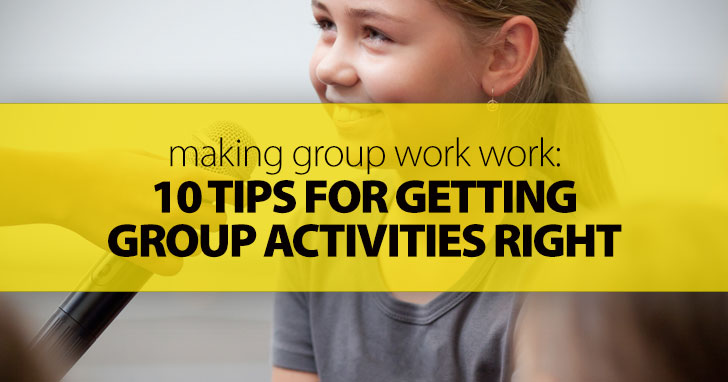Making Group Work Work: 10 Tips for Getting Group Activities Right


It involves relinquishing control of a uniform classroom as a teacher and suddenly having multiple micro-classrooms that you feel you need to run around and manage all at the same time.
It always sounds like a good idea. Put students into groups. Let them collaborate. They will effectively put their heads together and emerge with wonderful language skills. Instead, you see this: in one group, one student is doing all the work while the others chat about last weekend. In another group, one member refuses to let others help because they’ll do it wrong, so the others sit around on their cell phones. In another group, students insist on speaking in their native language, excluding their one group member who doesn’t speak this language.
So why do group work? Because group work can double and even triple the amount of a student’s language production as opposed to whole classroom instruction alone. In large groups, shy students get overlooked and students have mastered the “I-look-like-I’m-paying-attention-but-really-I’m-sleeping-with-my-eyes-open” look. You can’t constantly make sure all students are engaged, especially if your class is large. So, here are some tips and hints for making group work work for you.

There’s a time and a place to allow students to choose their own groups or even assign groups randomly. If you’ve got a wonderful class that you can do this with, excellent! It means you have great, motivated, eager students. If you perhaps don’t have that, try some of these strategies for choosing groups.
Line-ups
One way to get some energy out in this process is to have all students stand up in a line. Tell them that they have 15 seconds to rearrange themselves in a specific order, for example, alphabetical by last letter of their family name, birthday, number of siblings, alphabetical by favorite animal, and so on. Take a look at these results. Count off by the number of students you want in each group, and take a quick mental calculation as to whether you think these groups will work. If you see right away that two students are in the same group that probably will clash, try to regroup a different way or simply have them do another line-up until you get a more desirable result.
Character Match
You can also plan out groups ahead of time, but still make it seem random. One activity is choosing names of famous people, like presidents, Disney characters, superheroes, athletes, etc… Write individual names of these groups of people on sticky labels, and then attach them to students. For a quick version, put it on their front so they can see it, and for a longer version, put it on their back so that they have to ask others questions to figure out who they are. When they find out who they are, tell them to find the other students in their category and sit together as a group (e.g., all presidents in the back right corner and all actors in the front left.)
The easiest way for students to mentally check out during a lesson is to feel they have no responsibility or ownership in the activity. This is lessened by having small groups complete an activity, but it can still occur even in groups as small as two. For every activity you do, assign each group member a unique and specific role to get them involved and feeling like they have something to contribute. You can create any number of roles or combination of roles, but here are some that work well:
Now, even though you’ve assigned roles, this still won’t prevent all the previously discussed problems. One way to make sure each student is still contributing is by giving each role a unique color, and then put a sticker of that color on each student who is assigned that role. For example, if all the recorders have green stickers, you can quickly glance around and see if those students are maintaining their responsibility.
One of the biggest causes for student distraction is an unclear expectation of what they’re supposed to do. Demonstrate for your students what you want them to do and give them clear instructions. Do this before moving them into groups as the shift in the classroom causes chatter and a need for refocusing.
Group work isn’t simply a time-filler or an alternative way to teach. It should be producing valuable language production and students should get feedback on their performance. Whether you grade individually or as a group is up to you, but make your grading standards clear to the students before they begin. Consider alternative incentives as well such as stickers, candy, bonus points, or high-fives to groups who are working effectively together and staying on task. Seeing other groups positively rewarded for their group interaction will hopefully motivate other groups to do the same.
The more you do groups, the more students will understand the expectations and get used to working in a more student-centered environment. Collaboration is a valuable life-skill to learn for students and it will effectively build language production.
What kinds of student interaction patterns do you use in class?